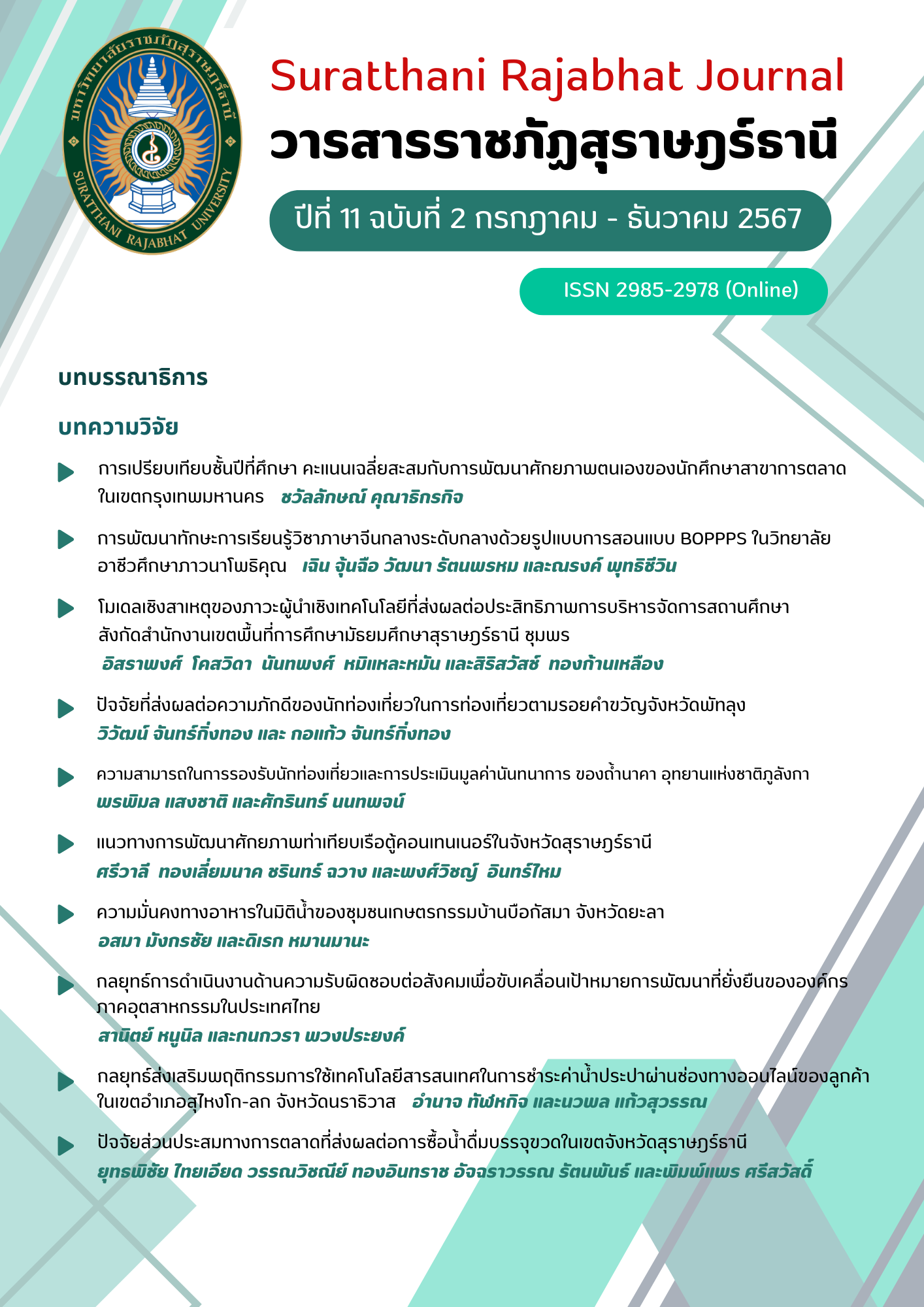Strategies to Promote the Use of Information Technology for Online Water Bill Payment by Customers in Su-ngai Kolok District, Narathiwat Province
Main Article Content
Abstract
The objectives of the study were to: 1) analyze the factors influencing customer behavior in using information technology, 2) examine the internal and external conditions of the provincial waterworks authority, and 3) propose strategies to encourage customers to use information technology to pay water bills through online channels. A mixed-method approach was employed, involving questionnaires, interview, and focus group discussions with 375 customers and 26 executives, supervisors, and employees. Data analysis included content analysis for qualitative data, while quantitative data were analyzed using averages, means, standard deviations, frequencies, and multiple regression. The findings revealed that participants' behaviors in using information technology to pay water bills was primarily at the acknowledgment or alertness stage. Three factors influencing the use of information technology for water bill payments were identified, with a predictive ability of 76.60 percent. The internal and external conditions of the provincial waterworks authority required improvements in areas such as safety, billing systems, and system complexity. Therefore, strategies to promote customer behavior in using information technology for online water bill payment included: strategies for developing an online water bill payment system, strategies for improving the billing system, proactive public relations strategies, and strategies to reduce limitations to accessing online water bill payment services. The results of this study lead to the development of an action plan and serve as a guideline to promote and drive the use of information technology enhancing efficiency and adding value to the organization's products and services.
Article Details

This work is licensed under a Creative Commons Attribution-NonCommercial-NoDerivatives 4.0 International License.
References
Aunruen, S. (2017). A Causal Relationship Model of Adoption and the Use of Technology that Affect Behaviours’ for the Shopping Applications on Smart Phones of the Population in Bangkok and its Vicinity [Unpublished master’s thesis]. Rangsit University.
Chaiwawattrakul, S. (2021). Readiness and satisfaction in using the mobile agricultural application prototype. Ubon Ratchathani University.
Chaweesuk, S. & Wongjatupat, S. (2012). Theory of acceptance of information technology use. KMITL Information Technology Journal, 1(1), 1-21. https://www.it.kmitl.ac.th/~journal/index.php/main_journal/article/download/2/4
Digital Thailand Development Plan. (2017). Digital Thailand. Office of the National Digital Economy and Society Commission.
Janthala, J., Pholphaengkwa, R., Dangsakul, K. & Sawang, K. (2023). Factors of Technology Acceptance Influencing Decision Making on DOPA Digital ID System Via Smartphone of User in Udonthani Province. Academic and research journals, Northeastern University, 13(2),46-60. https://so04.tci-thaijo.org/index.php/neuarj/article/view/263465/179539
Jarusen, J. (2021). Influence of financial transaction technology on the performance of small and medium enterprise operators. Dusit Thani College Journal, 15(2), 162-173. (in Thai).
Kaewsuwan, N. & Theppaya, T. (2023). Factors Influencing Information Technology Adoption of the Educational Opportunity Expansion Schools’ Teachers in Pattani Primary Educational Service Area in Pattani Province. Journal of Information and Learning, 34(1), 87-97. (in Thai). https://so04.tci-thaijo.org/index.php/jil/article/view/259021/178966
Khajannan, N. (2009). Strategic management. Se-ed SE-ED Publisher.
Khanabkaew, C. & Chaiprasit, K. (2019). Attitudes and risk perceptions that influence acceptance of E-Payment use through TMB Bank Public Company Limited in Bangkok. Journal of Management and Development, 6(1), 74-78. (in Thai). https://so06.tci-thaijo.org/index.php/JMDUBRU/article/view/202883/141507
Kiranandana, M. (2007). Educational technology and innovation. Aroon Printing.
Krejcie, R. V. & Morgan, D. W. (1970). Determining sample size for research activities. Educational and Psychological Measurement, 30(3), 607-610. https://journals.sagepub.com/doi/10.1177/001316447003000308
Leekitchwatana, P. (2012). Educational research methods. King Mongkut’s Institute of Technology Ladkrabang.
Ministry of Digital Economy and Society. (2021). Thailand's Information and Communication Technology Policy Framework 2011-2020 (ICT2020) approved by the Cabinet on 22 March 2011, Ministry of Digital Economy, and Society
Nimitphan, W. & Pholkanitha, S. (2016). Public Relations Strategy on Social Media. Eau Heritage Journal Social Science and Humanities, 6(1), 21-31. (in Thai). https://so01.tci-thaijo.org/index.php/EAUHJSocSci/article/view/56926/47312
Panjathawee, S. (2017). Factors affecting the acceptance of the use of information systems. A case study of the Institute of Physical Education, Chiang Mai Campus [Unpublished master’s thesis]. Chiang Mai University.
Panyawai, P. (2016). The Technology Acceptance and Country of Origin Affecting the Attitude on Pre-order Cosmetic via Online Business of Customer in Bangkok [Unpublished master’s thesis]. Bangkok University.
Phalasri, A., Khakkunmalee, R., Maneesi, S., Lalun, A. & Kwathai, L. (2021). The Relationship Between Literacy and Acceptance of Information Technology and the Information Technology Use Behaviors in the Nursing Practices of Nursing Students. Journal of Health and Nursing Education, 271), 43-57. (in Thai). https://he02.tci-thaijo.org/index.php/Jolbcnm/article/view/251872/171157
Phonlawan, T. (2014). Behavior of QR code technology of Bangkok population. Kasetsart Engineering Journal, 27(88), 29-40.
Rabsiri, R. (2007). Technology Integration Implementation: Critical Factor of Enhancing Service Quality, Sripatum University.
Roger, E. M., & Shoemaker, F. F. (2003). Diffusion of innovation fifth edition. The University of New Mexico.
Samran, L. (2021). Intention to use information technology of Provincial Electricity Authority employees, Suphanburi Province, Kanchanaburi Rajabhat University.
Songsri, A. (2017). Perception and behavior in using information technology of support personnel at Thaksin University. Thaksin University.
Supipatanasakul, T. (2017). The Influences of Service Quality, Ease of Use, and Security on Use, User Satisfaction, Word of Mouth and Continuance Intention of Customer Using e–Money on Smartphone. Bangkok University.
Tancharoen, S. (2017). Community Based Tourism Management and Sustainable Tourism Development of Bangkantaek Community in Samutsongkhram Province. Journal of International and Thai Tourism, 13(2), 1-24. (in Thai). https://so02.tci-thaijo.org/index.php/jitt/article/download/113052/88023/
Theeraphongsathorn, P. (2019). The Behavior for Using Technology in Work of Officers at JWS-Construction CO., LTD., Ramkhamhaeng University.
Thongkwaw, T., Pauwongsakul, S. & Wonnawed, N. (2022). Promoting the Usage of Information and Communication Technology for Education Administrators under Kanchanaburi Primary Educational Service Area Office 1. Journal of Institute of Trainer Monk Development, 5(3), 114-126. (in Thai). https://so06.tci-thaijo.org/index.php/tmd/article/view/257367/174294
Wimoltham, V. & Nilphab, C. (2021). The success of the information system affects the acceptance of mobile banking technology. Case study of customers of the Bank for Agriculture and Agricultural. Journal of Management and Development. Ubon Ratchathani Rajabhat University, 8(2), 93-109. (in Thai). https://www.researchgate.net/publication/366191644_The_Effect_of_Information_System_Success_on_Technology_Acceptance_of_Mobile_Banking_Customers_Case_Study_of_Bank_for_Agriculture_and_Agricultural_Cooperatives_in_Chaiyaphum_Province


